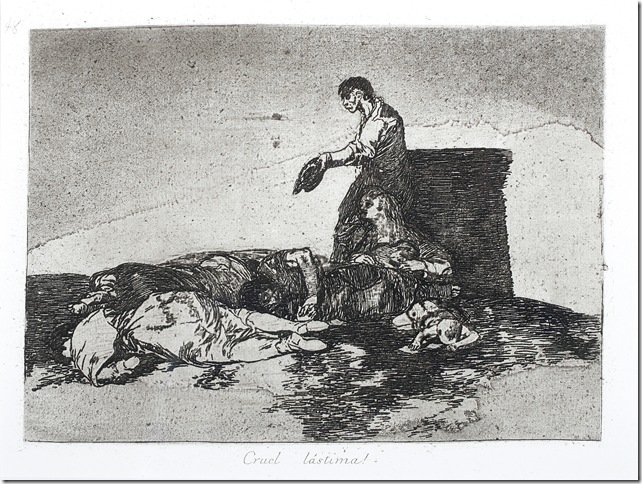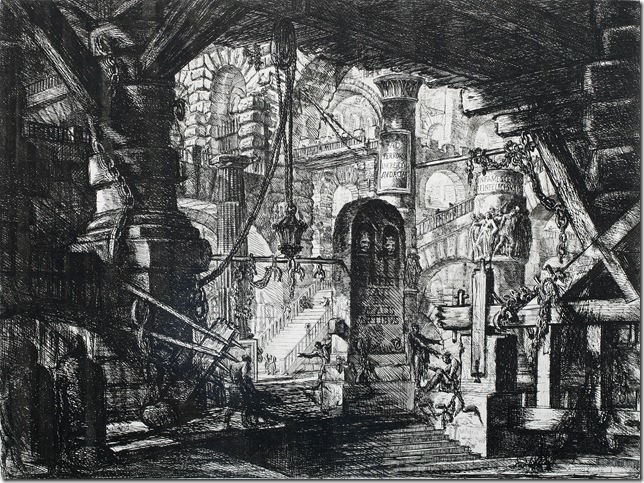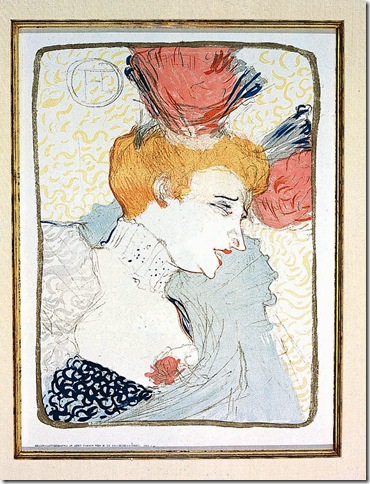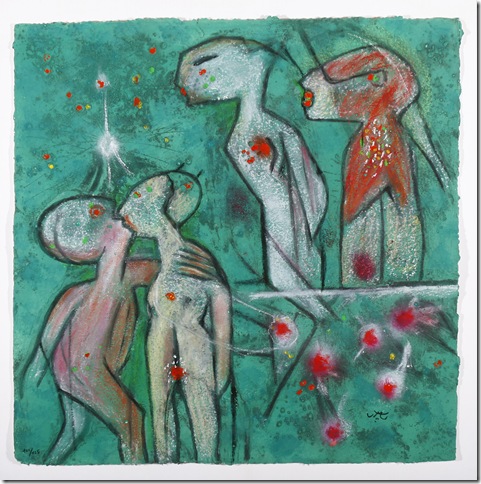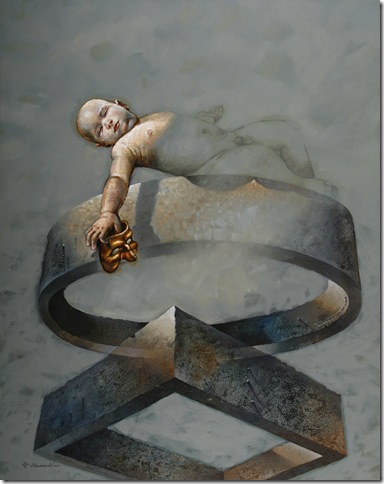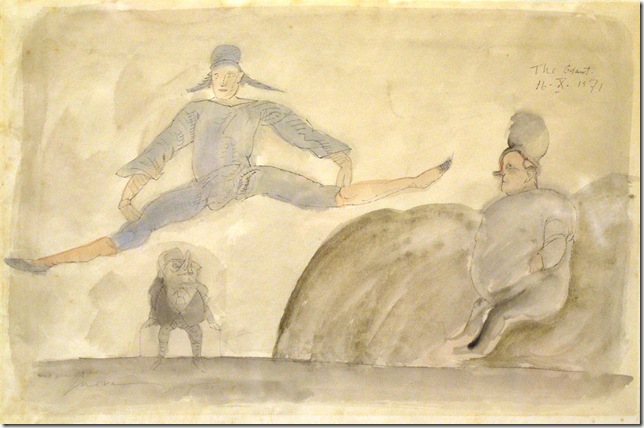Two of the current shows at the Boca Raton Museum of Art are easy to miss. But you don’t want to.
One gives us the dramatic touch of Goya, the playful Miró and the erotic side of Picasso. The other is a good bite of Latin American art. And I’m not talking Diego Rivera, Amelia Pelaez or Frida Kahlo. Believe it or not, Latin America has more where they came from.
More than 60 graphic works including lithographs, etchings and woodcuts encompass Romanticism to Modernism: Graphic Masterpieces from Piranesi to Picasso, running through June 19.
This is a black-and-white show for the most part, with six etchings from Francisco Goya’s series The Disasters of War as preamble. The 80-etchings series, published 35 years after Goya’s death, was not only a crystal-clear statement against the war but a steady one. That the artist produced more than 80 in a 10-year span (1810-1820) speaks to his strong unwavering position. As if the graphic content of the works did not speak loud enough, we get the artist’s comments as titles.
In Tampoco, (Nor this) violence and struggle are taking place right before our eyes. Much like Leonardo’s Battle of Anghiari (minus the horses) and Michelangelo’s Battle of the Centaurs, Goya’s figures appear intertwined, bodies pulled, twisted, folded in uncomfortable positions. The arms, legs and heads are hard to trace back to a source.
But the more you look, the clearer it becomes that the battle is already lost. Two swords lie to the right of the panel. The expression on the male figure in the foreground is one of pain and defeat. From his compromising position his left hand still tries to push the enemy away, but it’s already too late; he is too weak.
Cruel Lastima! (A Cruel Shame!) gives us a frail-looking man holding a hat who is left with no choice but to beg for money or food. He looks tired and his clothes seem dirty. At his feet, sitting on the ground, is a woman holding a child that could be dead or alive. Another child, with not even a full head of hair yet, lies facing the land. He is one of several corpses. It is a moving, somber depiction of misery and hunger that can still inspire compassion today, even from an audience daily fed with vivid accounts of tragedies.
The Pier with Chains, Plate XVI, from the series Carceri d’Invenzione (Imaginary Views of Prisons) continues the dark tone of the show but with a much more elaborate composition full of arches, columns and stairs. The shadowy little figurines appear to be adornments more than actual humans. That the structures seen here appear imaginary is no surprise: This is one in a series of prints by Giovanni Battista Piranesi, an Italian artist who is recognizable for his architectural fantasies and fictional representations of ruins. The style, known as caprice, usually welcomes the viewer in to examine the spaces and travel around the structure as if we were really there.
A departure from these dark visions of reality comes later with colorful pochoirs (stencils) by Joan Miró and works by Marc Chagall, Henri de Toulouse-Lautrec and Georges Rouault, who offers probably the boldest lines in the whole show with his infant-like pieces sharing the title: Cirque de l’Étoile Filante (The Shooting Star Circus).
Two samples from Miró’s famous Constellation Series are here, along with one of his most surreal prints: Personnages devant le mer (Figures by the sea) in which a couple reaching out to each other run the risk of becoming one and the same person. The female, shown with a frown and black and white breasts, is to the right.
One of my favorite stencils here – The Cock, by Miró — features bright reds, yellows and greens and the central figure of a bird singing to a red sun up in the sky. Looking at it we can almost hear the animal’s cry; it’s less of a song and more like scream, a loud necessary stance against that bloody sun or, perhaps, because of it.
The exhibit delivers the final touch with 21 of Pablo Picasso’s graphic works, including etchings from the Vollard Suite such as Faune Revealing a Sleeping Woman (Jupiter and Antiope, After Rembrandt). Here a hairy muscular man-beast gently uncovers the sleeping Antiope. As if ordered by gods, the sunlight travels from left to right revealing more than the female’s curves.
Combat de Centaures IV is a simple depiction of a battle where one has already lost. Think about conveying drama and aggression in a few words. Picasso does it here with minimal lines that travel freely from the right side of the print to the left, delivering a fatal touch.
Yes, some of these you have seen before, but it is worth revisiting just because of the references to gods and ancient myths, things Picasso did not usually have time for, not until he turned to Southern France, away from city lights. Before this, Paris was his god. Not here. Here we get Bacchus, knights and pages. Also, watch for the artist’s take on old Degas at a brothel surrounded by girls.
Romanticism to Modernism tries on dark, bold, then childish, sensual and provocative. Housed in the Education Gallery room, the show feels intimate and personal and is certainly worth our time. Unfortunately, because it is next to the colorful costumes exhibit (the main star among the shows now running) visitors are seduced away from it.
This is the same problem with the second show: Latin American Art from the Museum’s Collection, running through May 1. Most works here are done large-scale and are equally fascinating as those in the first show, though way smaller in number. But it is running in the auditorium, which means next to the museum store, and if you passed the admission/information counter you have already missed it.
At only 20 pieces, Latin American Art is meant as an introduction of important artists whose works portray themes many have expressed before: politics, society, cultural roots and the search for cultural identity. It is the diverse ways in which this group of artists, sharing the same culture, expresses these ideas that makes this a very nice show.
That internal journey/struggle to find one’s place in a new land is externalized here in SubRosa, a large-scale piece by Cuban artist Arturo Rodriguez, who has lived in Miami since 1974. The painting is divided into various panels shaped as tree leaves, each depicting a different event or scenes from the same story. The figures are almost always losing balance. They are either hanging, holding on to a rope or drowning.
In a few cases, they manage to fly aided with wings made out of leaves. The central figure is not an angel or a savior. Nobody is looking at her for help. It seems to me she is in the worst spot of all. Trapped in a blue middle, she is either being sucked in by the sky or from down under, maybe both at the same time. Everything is possible. A boat, in another panel, is sinking in a pool.
It is an image of chaos, constant movement, unpredictability. There is no place for certainty here or reassurance of any kind. And then, just like that, we step into Julio Larraz’s Atlantida, a set of three pieces offering tilted views of the sky and the sea. This Havana-born artist is known for his cloud studies and indeed, clouds are impressively depicted here.
If you have time, sit, take a minute or two to breathe the clean air. Imagine yourself on a speedboat or skydiving. From this high up, it is the dark deep blue sea that commands attention, respect and even fear. Don’t look down. Focus on the sky and be at ease.
These Larraz paintings are amazing in that very quickly they place us in the middle of a panoramic adventure no matter where you are standing in the room. One look at them is enough to take us there.
But one thing is true here. Every single piece, even those that may seem comical, carries a serious tone. Such is the case of Star of the Gardens, which Chilean artist Roberto Matta (1911-2002) created as a take on the man-machine interaction. Green has taken over the entire space. The figures do not look human, either.
To begin with, they have helmet-like heads. But two of them (the little ones to the left) give each other signs of affection while two “adults” (to the right) stare. Above the small figures a white star is erupting: There is hope (I guess).
Innocence plays a definite role in The Giraffe, by Uruguay’s Ignacio Iturria, and the work is done in real-kid fashion, meaning on cardboard, but the dark, limited colors take the fantasy away, replacing it with the vision of a seemingly tougher childhood.
On your way out, make sure to take a look at the three small figurative sculptures by Francisco Zúñiga (1912-1998), a Mexican artist born in Costa Rica. The ones here are done in bronze with green patina. Seated Nude, my favorite, is to the left. At 6 inches tall, it depicts a female squatting, slightly leaning toward the left and looking curiously at something. Both hands rest on her left foot, as if she had been there for a long time already.
As anticipated, Latin American Art leaves me wanting more. It is not that the works shown here do not impress me. It’s just that I’m greedy, which is why I like the idea of having more than one show to explore.
To have two exhibits of manageable sizes running at the same time makes more sense to me than putting together one huge show. Although when it comes to retrospectives, more is understandably the way to go. But this is not the case here. A tease is better than surfeit.
I don’t suggest you visit the museum and miss its main start. If you get pulled in by the eccentric fashion styles of Jack Sparrow and the Duchess, that’s perfectly all right. Just remember there are two additional shows hidden, like treasures, waiting to be noticed. They will not wait forever.
Frames always come down and news ones go up. But at least here, for now, you can have it all.
The Boca Raton Museum of Art is open from 10 a.m. to 5 p.m. Tuesdays, 10 a.m. to 9 p.m. Wednesdays, 10 a.m. to 7 p.m. Thursdays and Fridays, noon to 7 p.m. Saturdays and noon to 5 p.m. Sundays. Tickets (through April 17) are $14, $12 for senior citizens, $6 for students. Call 392-2500 or visit www.bocamuseum.org for more information.

